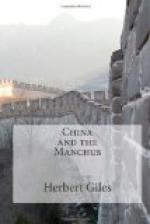“I have heard that in the past many would-be deliverers of their country have ascended this lofty mound wherein is your sepulchre. It has served to them as a holy inspiration. As they looked down upon the surrounding rivers and upward to the hills, under an alien sway, they wept in the bitterness of their hearts, but to-day their sorrow is turned into joy. The spiritual influences of your grave at Nanking have come once more into their own. The dragon crouches in majesty as of old, and the tiger surveys his domain and his ancient capital. Everywhere a beautiful repose doth reign. Your legions line the approaches to the sepulchre; a noble host stands expectant. Your people have come here to-day to inform your Majesty of the final victory. May this lofty shrine wherein you rest gain fresh lustre from to-day’s event, and may your example inspire your descendants in the times which are to come. Spirit! Accept this offering!”
We are told by an eye-witness, Dr Lim Boon-keng, that when this ceremony was over, Sun Yat-sen turned to address the assembly. “He was speechless with emotion for a minute; then he briefly declared how, after two hundred and sixty years, the nation had again recovered her freedom; and now that the curse of Manchu domination was removed, the free peoples of a united republic could pursue their rightful aspirations. Three cheers for the president were now called for, and the appeal was responded to vigorously. The cheering was taken up by the crowds below, and then carried miles away by the thousands of troops, to mingle with the booming of distant guns.”
LIST OF WORKS CONSULTED
The I yue kuo chi (costumes of strange nations). Circa 1380.
The Tung hua lu (a history of the Manchus down to A.D. 1735). 1765.
The Sheng wu chi (a history of the earlier wars under the Manchu dynasty). 1822.
A History of China, by Rev. J. Macgowan, 1897.
A History of the Manchus, by Rev. J. Ross, 1880.
The Chinese Repository.
The Chinese and their Rebellions, by T. T. Meadows, 1856.




